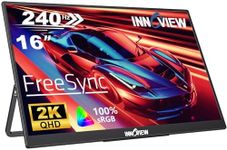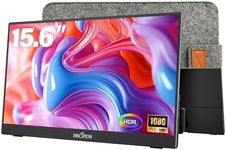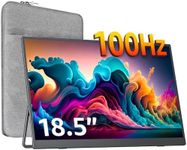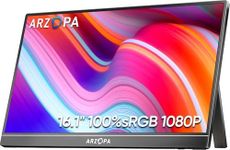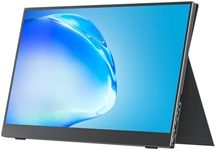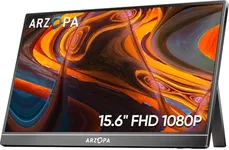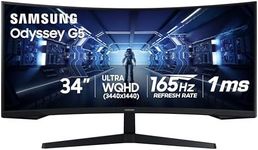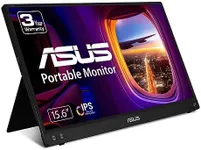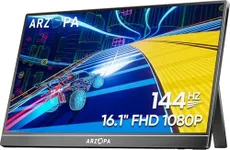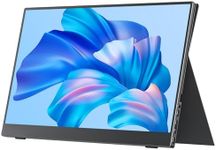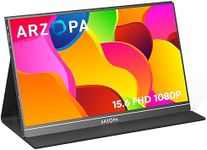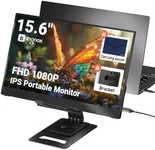Buying Guide for the Best Portable Monitors
When choosing a portable monitor, it's important to think about how and where you'll use it. Portable monitors are great for adding extra screen space when you're traveling, working remotely, or just want more flexibility at your desk. The right choice depends on your main activities—like work, gaming, or watching videos—and how much you value things like screen quality, size, and ease of connection. Understanding the key features will help you find a monitor that fits your needs and makes your experience smoother.Screen SizeScreen size refers to the diagonal measurement of the display, usually in inches. This is important because it affects how much content you can see at once and how portable the monitor is. Smaller screens, around 13 to 14 inches, are easier to carry and fit in most bags, making them ideal for travel. Medium sizes, like 15 to 16 inches, offer a balance between portability and workspace, which is good for productivity. Larger screens, 17 inches and above, give you more room for multitasking but are less convenient to carry. Think about how much space you need for your tasks and how often you'll be moving the monitor around.
ResolutionResolution is the number of pixels on the screen, which affects how sharp and clear images and text appear. Common resolutions are Full HD (1920x1080), Quad HD (2560x1440), and 4K (3840x2160). Full HD is usually enough for basic work, web browsing, and streaming. Higher resolutions like Quad HD or 4K are better for detailed work, such as photo editing or design, but they can also use more battery and may require a more powerful device to run smoothly. Choose a resolution that matches your main activities and the capabilities of your laptop or device.
Panel TypePanel type refers to the technology used in the screen, with the most common being IPS, TN, and OLED. IPS panels offer good color accuracy and wide viewing angles, making them great for most uses, especially creative work. TN panels are usually cheaper and have faster response times, which can be useful for gaming, but they often have poorer color and viewing angles. OLED panels provide excellent contrast and vibrant colors, but they can be more expensive and may use more power. Consider what matters most to you—color quality, speed, or battery life—when choosing a panel type.
ConnectivityConnectivity is about how the monitor connects to your devices. The most common options are USB-C, HDMI, and sometimes mini DisplayPort. USB-C is popular because it can carry both video and power with one cable, making setup simple and reducing clutter. HDMI is widely compatible with many devices but usually needs a separate power source. Some monitors offer both, which adds flexibility. Think about what ports your laptop or device has and whether you want a single-cable solution or don't mind carrying extra cables.
Weight and ThicknessWeight and thickness determine how easy it is to carry the monitor around. Lighter and thinner monitors are easier to slip into a bag and take on the go, which is important if you travel often or move between locations. Heavier or bulkier monitors might offer more features or a sturdier build but can be less convenient to transport. Consider how often you'll be moving the monitor and how much space you have in your bag or workspace.
Power SourcePower source refers to how the monitor gets its energy. Some portable monitors can run entirely off your laptop or device through a USB-C connection, which is very convenient. Others need a separate power adapter or battery. Monitors that draw power from your laptop may reduce your laptop's battery life, while those with their own power source can run longer but require you to carry an extra charger. Think about your typical setup and whether you need maximum portability or longer independent use.
Touchscreen CapabilitySome portable monitors offer touchscreen functionality, allowing you to interact directly with the screen. This can be useful for drawing, presentations, or navigating without a mouse. However, touchscreens can add to the cost and may not be necessary if you only need a second display for basic tasks. Decide if touch input will actually improve your workflow or if a standard display is enough for your needs.
Built-in FeaturesBuilt-in features can include things like speakers, stands, or protective covers. Integrated speakers are handy if you want audio without carrying extra gear, but they are usually basic in quality. Built-in stands or covers make it easier to set up the monitor anywhere, while some models require a separate stand. Think about which extras will make your experience more convenient and whether you prefer an all-in-one solution or don't mind using accessories.
